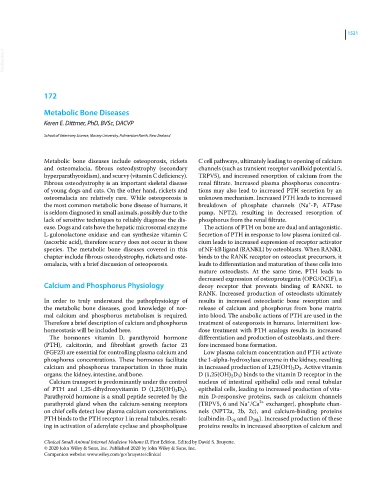Page 1583 - Clinical Small Animal Internal Medicine
P. 1583
1521
VetBooks.ir
172
Metabolic Bone Diseases
Keren E. Dittmer, PhD, BVSc, DACVP
School of Veterinary Science, Massey University, Palmerston North, New Zealand
Metabolic bone diseases include osteoporosis, rickets C cell pathways, ultimately leading to opening of calcium
and osteomalacia, fibrous osteodystrophy (secondary channels (such as transient receptor vanilloid potential 5,
hyperparathyroidism), and scurvy (vitamin C deficiency). TRPV5), and increased resorption of calcium from the
Fibrous osteodystrophy is an important skeletal disease renal filtrate. Increased plasma phosphorus concentra
of young dogs and cats. On the other hand, rickets and tions may also lead to increased PTH secretion by an
osteomalacia are relatively rare. While osteoporosis is unknown mechanism. Increased PTH leads to increased
+
the most common metabolic bone disease of humans, it breakdown of phosphate channels (Na ‐P i ATPase
is seldom diagnosed in small animals, possibly due to the pump, NPT2), resulting in decreased resorption of
lack of sensitive techniques to reliably diagnose the dis phosphorus from the renal filtrate.
ease. Dogs and cats have the hepatic microsomal enzyme The actions of PTH on bone are dual and antagonistic.
L‐gulonolactone oxidase and can synthesize vitamin C Secretion of PTH in response to low plasma ionized cal
(ascorbic acid), therefore scurvy does not occur in these cium leads to increased expression of receptor activator
species. The metabolic bone diseases covered in this of NF‐kB ligand (RANKL) by osteoblasts. When RANKL
chapter include fibrous osteodystrophy, rickets and oste binds to the RANK receptor on osteoclast precursors, it
omalacia, with a brief discussion of osteoporosis. leads to differentiation and maturation of these cells into
mature osteoclasts. At the same time, PTH leads to
decreased expression of osteoprotegerin (OPG/OCIF), a
Calcium and Phosphorus Physiology decoy receptor that prevents binding of RANKL to
RANK. Increased production of osteoclasts ultimately
In order to truly understand the pathophysiology of results in increased osteoclastic bone resorption and
the metabolic bone diseases, good knowledge of nor release of calcium and phosphorus from bone matrix
mal calcium and phosphorus metabolism is required. into blood. The anabolic actions of PTH are used in the
Therefore a brief description of calcium and phosphorus treatment of osteoporosis in humans. Intermittent low‐
homeostasis will be included here. dose treatment with PTH analogs results in increased
The hormones vitamin D, parathyroid hormone differentiation and production of osteoblasts, and there
(PTH), calcitonin, and fibroblast growth factor 23 fore increased bone formation.
(FGF23) are essential for controlling plasma calcium and Low plasma calcium concentration and PTH activate
phosphorus concentrations. These hormones facilitate the 1‐alpha‐hydroxylase enzyme in the kidney, resulting
calcium and phosphorus transportation in three main in increased production of 1,25(OH) 2 D 3 . Active vitamin
organs: the kidney, intestine, and bone. D (1,25(OH) 2 D 3 ) binds to the vitamin D receptor in the
Calcium transport is predominantly under the control nucleus of intestinal epithelial cells and renal tubular
of PTH and 1,25‐dihydroxyvitamin D (1,25(OH) 2 D 3 ). epithelial cells, leading to increased production of vita
Parathyroid hormone is a small peptide secreted by the min D‐responsive proteins, such as calcium channels
+
2+
parathyroid gland when the calcium‐sensing receptors (TRPV5, 6 and Na /Ca exchanger), phosphate chan
on chief cells detect low plasma calcium concentrations. nels (NPT2a, 2b, 2c), and calcium‐binding proteins
PTH binds to the PTH receptor 1 in renal tubules, result ( calbindin‐D 9k and D 28k ). Increased production of these
ing in activation of adenylate cyclase and phospholipase proteins results in increased absorption of calcium and
Clinical Small Animal Internal Medicine Volume II, First Edition. Edited by David S. Bruyette.
© 2020 John Wiley & Sons, Inc. Published 2020 by John Wiley & Sons, Inc.
Companion website: www.wiley.com/go/bruyette/clinical

